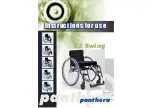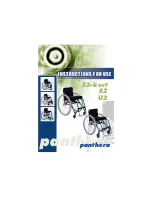
930476 Rev. E
9
P-222
VI. GENERAL WARNINGS
N.TRANSFERS
WARNING
It is dangerous to transfer on your own. It requires
good balance and agility. Be aware that there is a point
during every transfer when the wheelchair seat is not
below you. To avoid a fall:
1. Always turn off power before you transfer to or from your
chair. If you fail to do so you may touch the joystick and
cause your chair to move when you do not expect it.
2. Make sure motor locks are engaged. This keeps the chair
from moving when you transfer.
3. Work with your health care professional to learn safe methods.
•
Learn how to position your body and how to support
yourself during a transfer.
•
Have someone help you until you are sure you can do a
safe transfer on your own.
4. Move your chair as close as you can to the seat you are
transferring to. If possible, use a transfer board.
5. Rotate the front casters until they are as far forward as possible.
6. Be careful of the footrests. If you can, remove or swing them
out of the way.
•
Never stand on footrests when you transfer. Doing so
may damage them or cause your chair to tip.
•
Make sure your feet do not “hang up” or get caught in
the space between the footrests.
7. Make sure armrests do not interfere.
8. Transfer as far back onto the seat surface as you can. This will
reduce the risk that you will miss the seat or fall.
O.REACHING OR LEANING
WARNING
Reaching or leaning affects the center of balance of your
chair. If done improperly, a fall or tip-over is likely.
When in doubt, ask for help or use a device to extend
your reach.
To Reduce the Risk of injury and/or Damage to the Chair:
1. Never reach or lean if you must shift your weight sideways or
rise up off the seat.
2. Never reach or lean if you must move forward in your seat
to do so. Always keep your buttocks in contact with the
backrest.
3. Never reach with both hands (you may not be able to catch
yourself to prevent a fall if you lose your balance).
4. Never try to pick up an object from the floor by reaching down
between your knees.
5. Never put pressure on the footrests while reaching. This may
cause the chair to tip if you lean too far.
6. Never reach or lean over the top of the seat back. This may
damage the backrest and cause you to fall.
IF YOU MUST REACH OR LEAN; DO SO AT
YOUR OWN RISK.
Remember to:
1. Move your chair as close as you can to the object you wish
to reach.
2. Rotate the front casters until they are as far forward as possi-
ble. This makes the chair more stable.
NOTE–
To do this: Move your chair past the object you want to reach, then
back up alongside it. Backing up will rotate the casters forward.
3. Turn off all power to your chair. If you fail to do so, you may
touch the joystick and cause your chair to move when you
do not expect it.
4. Firmly grasp a rear wheel or an armrest with one hand. This
will help to prevent a fall if the chair tips.
P. DRESSING OR CHANGING CLOTHES
WARNING
Be aware that your weight will shift if you dress or
change clothes while seated in this chair. To make the
chair more stable, rotate the front casters until they are
forward.
Q.OBSTACLES
WARNING
Obstacles you may have to overcome in daily use
include door thresholds, lifts, ramps and hazards such as
potholes and broken pavement. These can damage your
chair and may cause a fall, tip-over or loss of control.
1. Be aware that thresholds are very dangerous. (Even a small
change in height may stop a caster wheel and cause your
chair to tip). You may need to:
•
Remove or cover threshold strips between rooms.
•
Install a ramp at entry or exit doors.
2. Keep your eyes moving when you ride; scan the area well
ahead of your chair.
3. Make sure the floor areas where you use this chair are level
and free of obstacles.
4. To help correct your center of balance:
•
Lean your upper body
forward
slightly as you go
up
over
an obstacle.
•
Press your upper body
backward
as you go
down
from a
higher to a lower level.
R. DRIVING IN REVERSE
WARNING
Use extra care when you drive your chair in reverse.
You may lose control or fall if one of the rear wheels
hits an object.
1. Operate your chair slowly and at an even speed.
2. Stop often and check to make sure your path is clear of
obstacles.










































